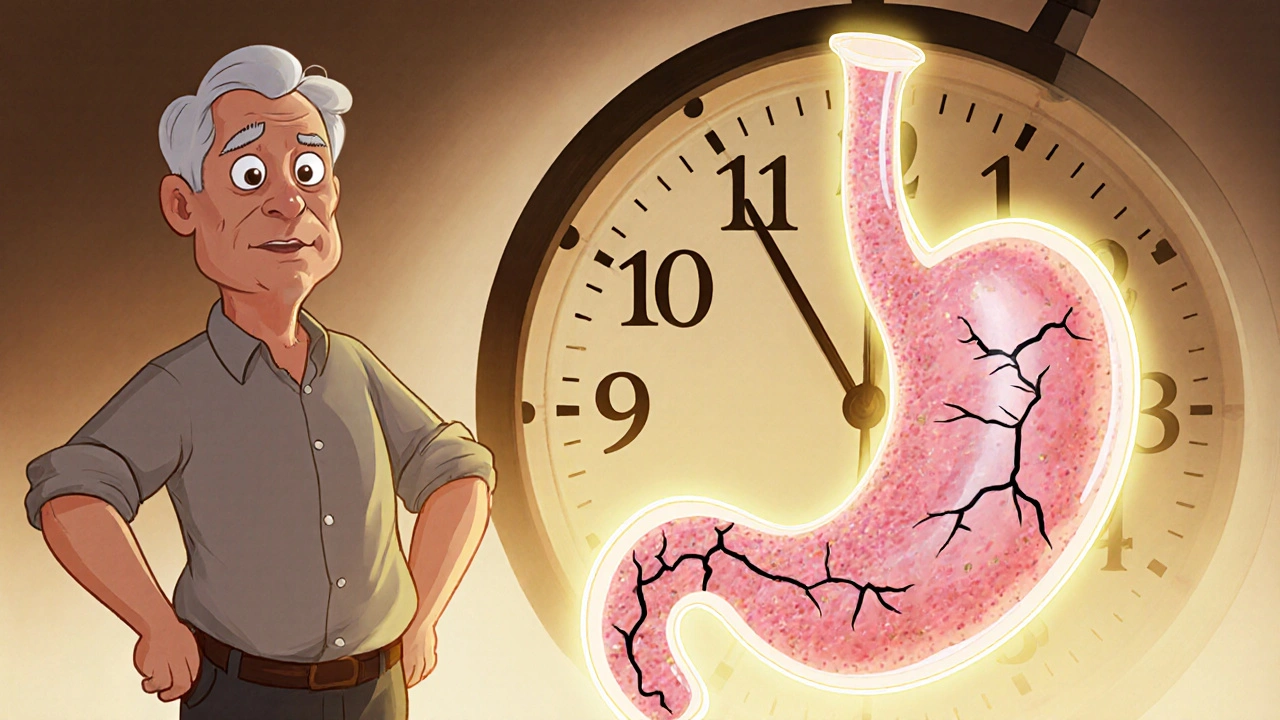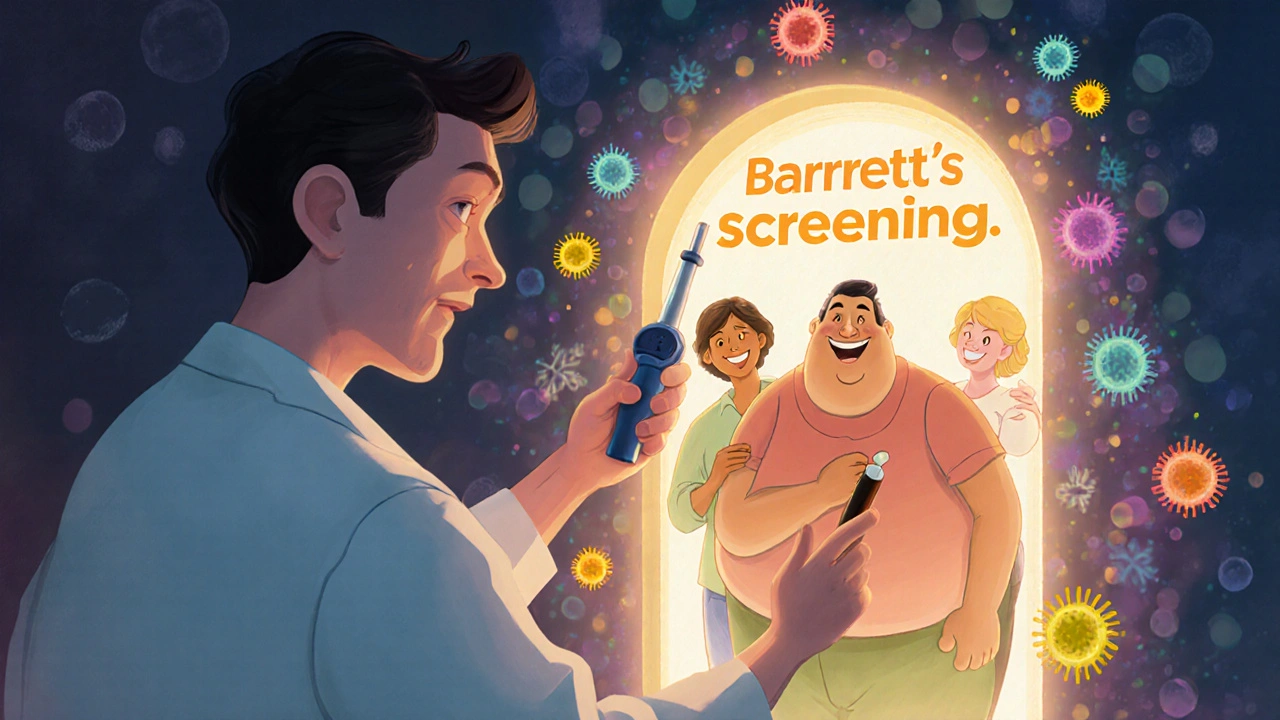Esophageal Cancer Risk: How Chronic GERD Turns Dangerous and When to Act

Chronic acid reflux isn’t just a nuisance-it’s a silent warning sign. If you’ve had heartburn for five years or more, especially if you’re a man over 50, overweight, or a smoker, you’re not just dealing with discomfort. You’re at risk for something far more serious: esophageal cancer. The good news? You don’t have to wait for symptoms to get worse. The better news? You can stop it before it starts-if you know what to look for.
Why Chronic GERD Is the #1 Risk Factor for Esophageal Cancer
Gastroesophageal reflux disease, or GERD, happens when stomach acid flows back into your esophagus regularly. It’s common-about 1 in 5 people in the U.S. have it. But for a small group, it doesn’t just cause burning. Over time, the acid damages the lining of the esophagus. Your body tries to fix it by replacing the normal cells with ones that look more like stomach lining. That’s called Barrett’s esophagus. And it’s the only known step before esophageal adenocarcinoma, the most common type of esophageal cancer today. A 2023 study from the NIH found that people with long-term GERD have more than three times the risk of developing esophageal cancer compared to those without it. That’s not a small increase. That’s a major red flag. And the longer you have GERD, the worse it gets. People with symptoms every week face a sevenfold higher risk. This isn’t random. The damage builds slowly. Acid exposure over five or more years-whether you’re on medication or not-is what pushes the cells into dangerous territory. Most people with GERD never get cancer. But for those who do, it almost always starts with this pattern: years of reflux → Barrett’s esophagus → cancer.Who’s Most at Risk? The Real Red Flags
Not everyone with GERD needs to panic. But some people are in a much higher-risk group. If you match even a few of these, you should talk to a doctor about screening:- Male-Men are 3 to 4 times more likely than women to develop this cancer.
- Over 50-90% of cases happen in people over 55. New or worsening reflux after 50 is a big deal.
- White, non-Hispanic-White Americans have three times the rate of adenocarcinoma compared to Black Americans.
- Obese (BMI 30+)-Extra weight pushes stomach contents upward. Obesity causes 30-40% of GERD cases.
- Smoker-Current or former smokers have 2 to 3 times higher risk.
- Family history-If a parent or sibling had esophageal cancer, your risk goes up.
- GERD for 10+ years-Even mild symptoms, if they’ve lasted a decade, put you in the danger zone.
Combine two or more of these, and your risk jumps. Combine three or more? You’re in the high-risk group that guidelines say should get an endoscopy. And yet, only 13% of people who qualify actually get screened.

What Symptoms Should You Never Ignore?
Most people with early esophageal cancer feel fine. That’s why it’s so deadly. By the time symptoms show up, the cancer is often advanced. But there are warning signs that don’t lie. If you have any of these, see a doctor now:- Dysphagia-Feeling like food is stuck in your chest or throat. It usually starts with solids, then moves to liquids. This is the most common symptom-seen in 80% of diagnosed cases.
- Unexplained weight loss-Losing more than 10 pounds in six months without trying? That’s not normal. It happens in 60-70% of cases.
- Heartburn that won’t quit-If you’re having it more than twice a week for five years or more, you’re past the ‘annoying’ stage.
- Food impaction-Food gets stuck and you can’t swallow it down. This occurs in 30-40% of patients.
- Chronic hoarseness or cough-If your voice is raspy or you’re coughing constantly for more than two weeks, acid may be reaching your throat and voice box.
Doctors see this all the time. People brush off hoarseness as a cold. They think weight loss is just stress. They assume heartburn is ‘normal’ after dinner. But these aren’t minor issues. They’re the body screaming for help.
How to Stop It Before It Starts
The truth is, you can lower your risk-even if you’ve had GERD for years. It’s not about perfection. It’s about smart, consistent changes.- Quit smoking-Your risk drops by half within 10 years of quitting.
- Loosen your belt-Losing just 5-10% of your body weight cuts GERD symptoms by 40%. That’s a game-changer.
- Limit alcohol-Stick to one drink a day for women, two for men. Heavy drinking raises a different type of esophageal cancer, but it still adds risk.
- Take your PPIs as prescribed-If you’ve been diagnosed with Barrett’s esophagus, taking proton pump inhibitors (PPIs) like omeprazole daily for five+ years cuts cancer risk by 70%.
- Get screened-If you’re a white male over 50 with chronic GERD and two other risk factors, an endoscopy is recommended. It’s a simple, quick procedure. A camera checks your esophagus. If Barrett’s is found, you can monitor it. If dysplasia shows up, they can remove it before it turns cancerous.
Endoscopic surveillance for Barrett’s esophagus reduces cancer deaths by 60-70%. That’s not a guess. That’s proven data. And new tools like the Cytosponge-a pill you swallow with a string attached that collects cells from your esophagus-are making screening easier and less invasive. In one study, it caught 80% of Barrett’s cases.

The Big Picture: Why This Matters Now
Esophageal adenocarcinoma has skyrocketed since the 1970s-up 850%. Why? Obesity. GERD. Lifestyle. While squamous cell cancer (linked to smoking and alcohol) is going down, the adenocarcinoma type tied to reflux keeps climbing. In 2023, the American Cancer Society estimated over 21,000 new cases and nearly 17,000 deaths in the U.S. alone. The scary part? Only 21% of people survive five years after diagnosis. But if caught early-before it spreads-the survival rate jumps to 50-60%. That’s the difference between a death sentence and a manageable condition. Yet most people wait until it’s too late. They don’t connect their heartburn to cancer. They don’t realize that GERD isn’t just a digestive issue-it’s a cancer risk. And they don’t know that screening exists.What to Do Next
If you’ve had acid reflux for five years or more, especially if you’re a man over 50, overweight, or smoke:- Write down your symptoms: How often? How bad? Any trouble swallowing?
- Check your risk factors: Age, sex, weight, smoking, family history.
- Call your doctor. Say: ‘I’ve had GERD for over five years. I’m concerned about Barrett’s esophagus. Should I get an endoscopy?’
- If you’re diagnosed with Barrett’s, follow up regularly. Don’t skip appointments.
- Make lifestyle changes now. Weight loss, quitting smoking, and consistent PPI use can change your outcome.
You don’t need to be scared. But you do need to be informed. This isn’t about fear. It’s about control. You can’t change your age or your genes. But you can change your habits. And you can ask the right questions. That’s how you protect yourself.
Does all GERD lead to esophageal cancer?
No. Only about 10-15% of people with chronic GERD develop Barrett’s esophagus, and of those, only 0.2-0.5% per year progress to cancer. But because GERD affects 20% of the population, even a small percentage turning into cancer adds up. That’s why screening is focused on high-risk groups-not everyone with heartburn.
Can I reverse Barrett’s esophagus?
In some cases, yes. With consistent PPI use, weight loss, and lifestyle changes, the abnormal cells can revert to normal in up to 25% of patients. Even if they don’t fully disappear, regular monitoring lets doctors catch any changes early. Advanced endoscopic techniques can also remove precancerous tissue before it becomes cancer.
Is an endoscopy dangerous or painful?
It’s not painful. You’re given light sedation, so you’re relaxed and won’t remember it. The procedure takes about 15 minutes. You might feel bloated afterward, but most people go home the same day. The risks are extremely low-bleeding or perforation happens in less than 1 in 1,000 cases. The benefit-catching cancer early-far outweighs the risk.
What if I’m not white or male? Am I still at risk?
Yes, but your risk is lower. The highest rates are in white men over 50 with multiple risk factors. However, anyone with long-term GERD, obesity, or smoking history can develop Barrett’s esophagus and cancer. Guidelines focus on the highest-risk group because they benefit most from screening. But if you have GERD for 10+ years and other risk factors, talk to your doctor-even if you don’t fit the classic profile.
Can diet alone fix GERD and prevent cancer?
Diet helps-avoiding spicy food, caffeine, alcohol, and eating smaller meals can reduce symptoms. But it won’t fix the underlying problem if you have chronic reflux. Medications like PPIs are often needed to stop the acid damage. And if you’ve had GERD for five+ years, diet alone won’t undo the cellular changes. That’s why screening and medical management are essential.
How often should I get screened if I have Barrett’s esophagus?
If your biopsy shows no dysplasia (no abnormal cells), you’ll typically get an endoscopy every 3-5 years. If low-grade dysplasia is found, you’ll need one every 6-12 months. High-grade dysplasia often leads to treatment to remove the abnormal tissue. Your doctor will tailor the schedule based on your specific results and risk factors.

I’ve had GERD for 8 years and never thought it could lead to cancer. This post literally changed my perspective. I’m scheduling an endoscopy next week. If you’re reading this and you’ve had heartburn for years, don’t wait until you can’t swallow. Do it now.
It’s not fear-it’s responsibility.
They’re hiding the truth. Big Pharma doesn’t want you to know that PPIs make the acid reflux worse over time. They’re just masking the problem so you keep buying pills. The real fix? Stop eating processed food. Cut out gluten. Your gut will thank you. Endoscopy? That’s just a money grab.
They’re selling you fear to sell you drugs.
Let’s be real-this article is just fearmongering dressed up as public health advice. 0.5% annual progression? That’s a 1 in 200 chance. You’re more likely to get struck by lightning than develop cancer from GERD. And yet, everyone’s rushing to get scoped like it’s a TikTok trend.
Meanwhile, actual cancer risks like asbestos, radon, and HPV are getting ignored. This is performative health anxiety.
bro i had heartburn for 12 yrs and never got cancer… so this whole thing is prob just hype. i dont trust doctors anyway. they just wanna stick tubes in u for cash. ppi’s are trash. i just drink baking soda now. works better.
also i smoke but im fine lol
I’m so glad someone wrote this. I’ve been telling my dad for years that his daily heartburn isn’t normal. He’s 62, overweight, smokes-classic risk profile. He finally agreed to the endoscopy last month. Turns out he had low-grade dysplasia. They removed it. He’s now on PPIs and lost 15 pounds.
You don’t have to be scared. But you do have to be proactive. This isn’t a ‘maybe’-it’s a ‘when.’
Does the Cytosponge test work for people who aren’t white? I’m mixed race and my dad had GERD for 20 years. The article says screening is focused on white men, but what about the rest of us? Is the data just biased or is the tech less accurate for other ethnicities?
Correction: The 2023 NIH study didn’t find ‘more than three times the risk’-it found an adjusted hazard ratio of 3.2 (95% CI: 2.8–3.7). Also, Barrett’s esophagus progression to cancer is 0.12% to 0.5% per year, not ‘0.2–0.5%’ as stated. Precision matters when people’s lives are at stake.
And yes, diet alone won’t fix it. But neither will PPIs if you’re still obese and smoking. This isn’t a pill problem-it’s a lifestyle problem.
It’s important to recognize that while the data presented here is clinically sound, the framing of this issue often leads to unnecessary anxiety among the general population. The vast majority of individuals with chronic GERD will never develop esophageal adenocarcinoma. However, for those who meet the high-risk criteria-male, over 50, obese, smoker, long duration-screening is not only appropriate, it is life-saving.
What we must emphasize is not fear, but awareness. And awareness must be paired with access. Too many individuals, particularly in underserved communities, lack the means to obtain even basic gastroenterology referrals. We must advocate for systemic change alongside individual action.
My cousin died of this. She was 58. She had heartburn for 15 years. Her doctor told her it was ‘just acid.’ She lost 40 pounds. She couldn’t eat. She went to the ER and they found stage 4 cancer. She was dead in 4 months.
Don’t be like her. Don’t wait for the ‘classic’ symptoms. If you’re over 50 and you’ve had reflux for more than five years, GET SCOPED. Even if you feel fine. Even if you think it’s ‘normal.’
I’m not mad. I’m just done letting people ignore this.
This is exactly the kind of public health education we need. The fact that only 13% of eligible patients get screened is a scandal. We have a proven, minimally invasive tool that reduces mortality by 60–70%-and yet, primary care providers still don’t routinely recommend it.
Patients need to be empowered to ask for it. Providers need to be educated to offer it. Insurance companies need to cover it without barriers. This isn’t optional. It’s standard of care.
I used to think my hoarse voice was just from yelling at my kids. Turns out it was acid burning my vocal cords. I didn’t connect it until I read this. I’m 47, female, overweight, had GERD since 35. I went to the doctor last week. Found Barrett’s. No dysplasia. But now I’m on PPIs, lost 10 pounds, and quit smoking.
This isn’t about being perfect. It’s about being present. Your body is trying to tell you something. Listen.
heartburn for 7 yrs. no cancer. prob fine. just eat less pizza.
I’m a nurse and I see this all the time. People come in with dysphagia and say, ‘I thought it was just my throat.’ No. It’s your esophagus screaming. I had a patient last month who ignored it for a year. She’s in chemo now.
If you’re reading this and you’ve had reflux for years, please-don’t wait. Not for your sake. For the people who love you.
I’ve been managing GERD for over a decade now. I used to think it was just part of aging. But after reading this, I realized I had four risk factors: male, over 50, overweight, and smoker. I quit smoking last month. Started walking 30 minutes a day. Lost 8 pounds. And I scheduled my endoscopy for next week.
This isn’t about fear. It’s about taking back control. You can’t change your age, but you can change your habits. And that’s the most powerful thing you can do.